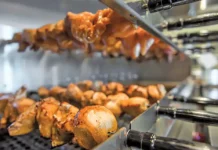
Despite years spent trying to effectively reduce food waste in restaurants, the numbers don’t paint a pretty picture.
According to the National Restaurant Association, on average, a restaurant loses 4-10% of its purchased food, often due to over-ordering. Throwing away food is throwing away money, and waste at this volume can stack up fast. It’s often one of the first places to look to control your variable costs on the P&L statement. On the flip side, an effective food waste management strategy has the potential to boost your restaurant’s profits. In fact, research shows that for every dollar a company invests into reducing food loss and waste, they stand to save $14 in operating costs. That’s a huge return!
Better inventory management is the key that lets you reduce food waste — ordering the right amount of ingredients, having effective processes, the right recipes, and a knowledgeable staff. Over the years, restaurants have tried to solve the daunting task of inventory management with back office technology. And while these systems have helped to a certain degree, they still make life difficult for both operators and managers. Managers are forced to work on too many different systems, diminishing the amount of support your staff can truly gain from these tools.
The good news? That’s changing. The next generation of restaurant operating platforms is significantly improving inventory management with three new capabilities—smarter forecasting, proactive reporting, and intelligent workflows. Together, these functions are helping restaurants more effectively manage inventory and greatly reduce food waste. Read on to find out how…
1. Better Ordering Through Smarter Forecasting
When it comes to inventory ordering, who are managers going to trust—a machine or their gut instinct? Many managers would prefer to go with their guts. After all, they’ve likely been in the business a long time and have developed a sixth sense for these things. Or so they think. But the reality is that however well-honed a manager’s inventory instincts are, ordering on gut alone can result in miscalculations and food waste.
For example, if a manager knows that fried chicken is the most popular dish on the Sunday brunch menu, they may believe they need to order 15 cases to meet demand. Even if their forecasting technology tells them they need to order 10 cases, they will likely be inclined to go with their gut. The problem is the system may have insight that the manager doesn’t, such as the fact that it’s predicted to be colder than usual on Sunday and customers typically order burgers when the temperatures drop. If the restaurant manager orders 15 cases of chicken, a large percent will go to waste.
What’s missing in the gut-versus-technology ordering struggle is providing managers with evidence that the recommended order is accurate. Restaurant systems can share insights and corrective actions, taking information out of the “black box,” such as the upcoming weather forecast and restaurant sales history. With this additional insight demystifying the process, managers can learn to trust their forecasts and recalibrate their gut instinct.
2. Intelligent Workflows are Recipes for Success
Chefs never prepare dishes without recipes. They rely on carefully documented step-by-step cooking instructions to ensure consistency, efficiency, cost savings, and customer satisfaction. They also rely on food and beverage managers to make the right decisions around food and stock purchases, and to sometimes ensure that employees are properly trained in food preparation. Just like chefs, food and beverage managers shouldn’t prepare without their own “recipes” for efficiency and success. Too often, ordering on the fly can result in costly mistakes and wasted food.
Today, the “recipe” concept is being extended into other areas of restaurant management, such as inventory ordering, in the form of intelligent workflows. They connect tasks, teams, processes, and data to provide actionable insights that remove the guesswork. For example, a typical inventory workflow for a shift manager would be a notification telling them that, based on projected sales volume during the shift, they will have extra salmon steaks. The workflow wouldn’t stop there, however. It would also provide suggestions for dealing with the issue, such as suggesting which best-selling menu items and specials to run that evening to use the over-stocked ingredient. In this way, managers are not just supported in inventory management at the initial point of food ordering, but also on the fly throughout their shifts.
3. Employ Proactive Reporting Insights Before Disasters Happen
Say the kitchen is getting low on marinated chicken breasts mid-shift, and the management system sends the manager an alert. What should he or she do? The “old-school” approach would be for the manager to head to the back office and begin pulling reports to try and unearth the ideal corrective action. But this type of manual process can be clunky, slow, and frustrating. While the manager is in the back office buried in paperwork, the kitchen staff is calling 86 as it approaches the end of the marinated chicken breasts.
A better approach would be to let the same system that sent the alert also offer the best proactive, reactive, and corrective solutions based on all available data. Instead of wasting time manually generating reports, the proactive reporting can provide suggested actions that will guide managers toward making decisions that will deliver the most profitable results and the best customer experience—all while preventing mistakes before they happen.
With today’s advanced inventory ordering capabilities, restaurant managers are better equipped to maintain high-quality, consistent product delivery that meets expected sales volumes and reduces the high cost of waste. Three new capabilities—advanced forecasting, proactive reporting, and intelligent workflows—are helping restaurants manage inventory levels, reduce costs, eliminate waste, and maximize revenue today.
























Comments are closed.